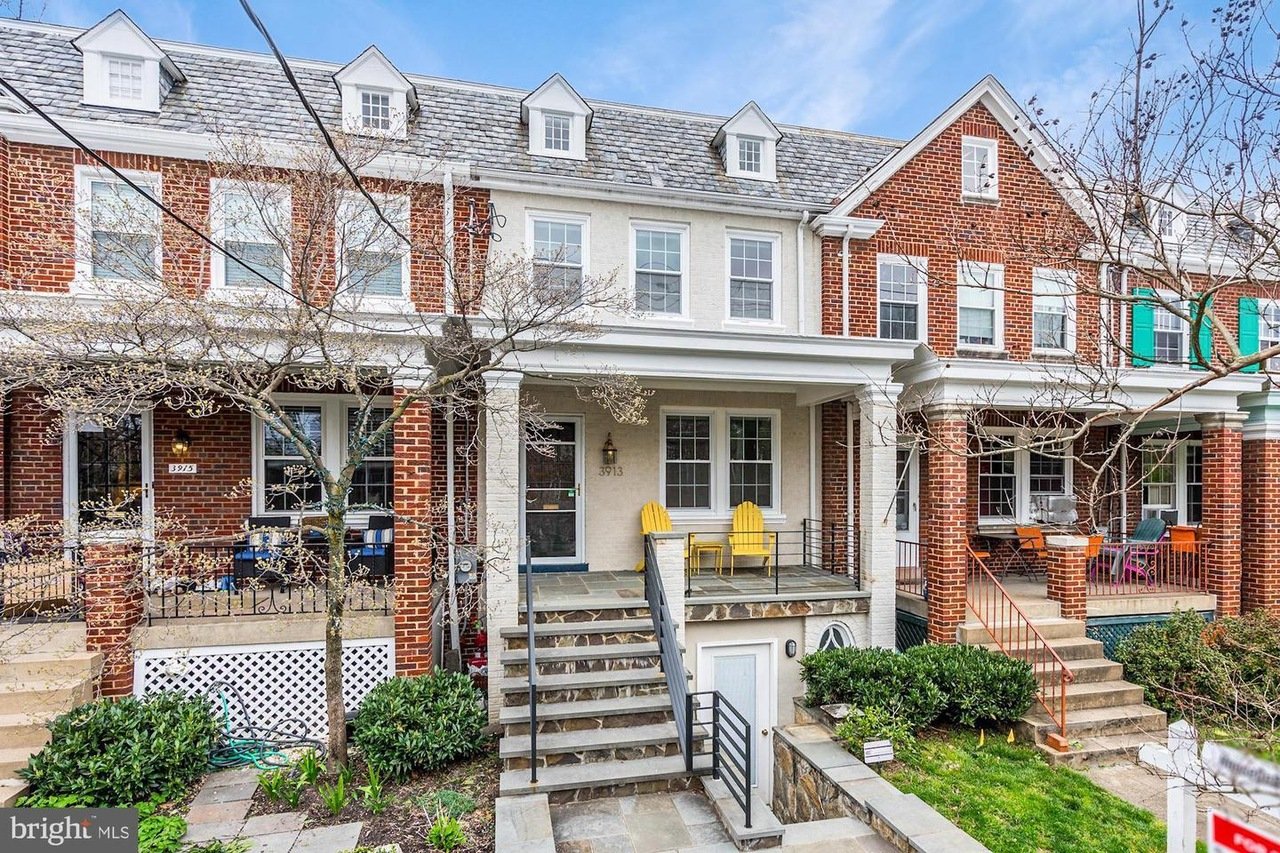→ Great Design Advice by the Hour
Looking around Raji Radhakrishnan’s house in Ashburn, you’d never guess she’s a bargain hunter. Her stunning Georgian manor was featured in Metropolitan Home last year.
But Radhakrishnan, a rising star on the local interior-design scene, has blended ultra-high-end pieces—including art by Roy Lichtenstein and pricey antiques—with inexpensive finds from Crate & Barrel, eBay, and Ikea. It’s nearly impossible to tell the high from the low.
Take the eye-catching club chairs in her master bedroom: Radhakrishnan bought them on eBay for $200 and paid $800 to have them re-covered in scraps of different fabrics. She thinks they could now sell for at least $4,000.
In her family room, a $12,000 custom sofa sits atop a sisal rug from Pottery Barn, and the curtains are from Ikea. She redid her powder room for less than $1,000 using marble she found on sale for $75, a faucet and sink from Ikea, and a long bench repurposed as a vanity top.
Thanks to the recession, such resourcefulness is in. Designers say they’re hearing from clients—even wealthy ones—looking for ways to squeeze more from their budgets.
Designer Jennie Curtis, who is based in Sterling, likes to use accessories from HomeGoods—especially throw pillows and glass and ceramic objects—in even her high-end projects. She says it’s fun to have one or two inexpensive finds mixed in with exquisite antiques.
A smaller budget can lead to creative ideas and a more interesting finished product. “It’s the quality of the thinking that counts,” says DC designer Mary Douglas Drysdale.
How do you save money without sacrificing style? Designers often have much smaller budgets than their clients do, especially when they’re starting out. We asked what strategies they used in their own homes.
Free Design Fixes
In a space that has started to feel stale, try this trick: Take everything out, including the art. Add pieces back in one at a time, not necessarily where they were before.
Don’t push all your furniture up against the walls; designers say this is one of the biggest mistakes they see. It’s counterintuitive, but pulling furniture closer together and at least a few feet from a wall can make the space feel larger and more comfortable.
On bookshelves, pull books forward so the spines are at the front edge of the shelves; that way your books will reflect light instead of creating shadows.
Try grouping artwork together by color or theme, and get creative with what you hang. It doesn’t have to be art in the traditional sense; you can frame children’s artwork, wedding invitations, or large-print wallpaper.
In her upstairs hallway, DC designer Liz Levin mixed art and family photos with travel souvenirs, including a shopping bag she got in London. It worked because everything was black and white.
Scavenge in your attic or other parts of the house for forgotten items. As soon as the room looks fresh and balanced, stop. “Editing it down is just as important as adding things,” says Sarah Wessel, a designer in DC. “Less sometimes looks more expensive.”
Almost-Free Fixes
If this approach doesn’t freshen up a room, you might add new throw pillows and have artwork rematted in a different color. You’d be surprised, say designers, how much this can change a room.
Wessel has a client who planned to buy an $8,000 sofa but put the purchase on hold after losing money in the stock market. As a temporary fix, the client ordered new throw pillows for $500. They were such an improvement that she no longer feels she needs the new sofa.
Custom pillows can be pricey. To save money, says designer Sally Steponkus, use a basic solid fabric on the back and splurge on a beautiful print for the front.
You can also find stylish pillows for less at retail. Steponkus has four custom pillows on her sofa that cost $250 each and two $25 pillows from Target on her living-room chairs. She gets more compliments on the Target pillows.
Steponkus is also a fan of decorative trays from Crate & Barrel, Pottery Barn, and World Market. She places them on ottomans, coffee tables, and side tables, and fills them with books, a plant, or other objects.
A fresh coat of paint can do wonders, not just for walls. Instead of repairing the creaky floors in his Dupont Circle condo, designer Joe Ireland painted them white—it’s a fresh, clean look that he also uses in clients’ homes. He uses Benjamin Moore’s porch-and-floor paint and suggests sticking to white, espresso, or another neutral.
Ireland’s business partner, Julie Weber-Levine, suggests another inexpensive improvement: Put your lights on dimmers and switch from yellowish light bulbs to white. She likes GE’s Reveal bulbs. “It makes a huge difference,” she says.
Pick Your Stars First
If you’re redecorating a room, you’ve probably looked through design books and magazines to get a sense of the look you want. Don’t worry if you can’t picture every last thing. You want to choose a room’s dominant pieces first—whether a painting, a rug, or a sofa—and then fill in around them.
Think of your room as a play, says DC designer Emily Bishop: “You have your lead actors and your supporting actors.”
You’ll want a color scheme that includes background and accent colors. If you have a favorite rug or piece of art, use that as a starting point. Curtis suggests carrying paint chips that match all your colors so that you don’t end up buying things that don’t go.
Buy to Last
You can save in the long run by shopping with an eye toward the future, even if it means a bigger cost up front.
“There is an enormous difference between inexpensive and cheap,” says Bethesda designer Tracy Morris. “If you want to use a piece for years, get something that is basic and you know will last.”
For high-quality case goods, look for solid wood, dovetailed joinery, and dowels or screws instead of staples. For a long-lasting sofa, look for kiln-dried wood, eight-way hand-tied springs, and well-padded arms. Of the national stores, designers like Crate & Barrel’s upholstery best.
Outdoor fabrics, most leather, Ultrasuede, synthetic blends, and Teflon-coated fabrics hold up under heavy wear and tear. Before choosing, you may want to check the fabric’s “double-rub” test, which gives a rating for durability, suggests McLean designer Barbara Hawthorn. She says fabrics with a score of 15,000 to 30,000 can withstand kids and pets.
Consider buying big-ticket items in neutral shades and simple styles. You can add color and trends with accents and later easily change things up.
Set Priorities
As a general rule, designers suggest spending more on things that will get heavy use—such as the family-room sofa—and statement pieces that will add a lot of style. To make bargains inconspicuous, Morris suggests, pick three to five more-expensive things that people will focus on when they enter the room.
Most designers say they never scrimp on window treatments because high-end custom drapes or shades can make a room. But when pressed on what they would do if they had to cut costs—custom drapes can cost $1,000 or more per window—many said they would order natural-grass shades or matchstick or wood blinds from a company such as Next Day Blinds or Blinds to Go or buy panel curtains or Roman shades from Pottery Barn, West Elm, Ikea, or Restoration Hardware.
For floor coverings, a designer bargain tip is to buy carpet remnants—pieces left over from big jobs—and have the edges bound. Designers also like sisal and seagrass, which are affordable yet often used in high-end homes, and Flor carpet tiles, which allow you to replace a small segment if the carpet gets stained or damaged.
Choose a rug that’s big enough for your room. “That’s one thing I can’t bite my tongue about,” says Samantha Friedman, a Gaithersburg designer who says she often sees living-room rugs that leave the sofa and chairs on the bare floor. Rugs should extend at least one foot under the sofa, she says.
Another place not to skimp: paint. You won’t save much by buying cheap paint, and there is a difference. High-quality paint goes on more evenly, has a richer color, and holds up longer. You may even need fewer coats. Farrow & Ball is generally considered the best, but Benjamin Moore’s Aura line is easier to find and almost as good. Some designers also like C2 paint.
New Life for Old Things
You can often get better-quality furniture for the money by buying used, and mixing in older things can make a space look sophisticated.
But whether an item is worth refurbishing depends on what it is; designers have lots of stories of “bargain” finds they spent thousands to repair. Check with an upholstery shop or refinisher for a rough estimate before purchasing.
You can save a lot by refinishing pieces yourself. For her own dining room, Jennie Curtis restored a 1940s table she bought at the Old Lucketts Store in Leesburg for $395.
The table was painted battleship gray. She stripped it, stained the top, and glazed the base. She says it would now fetch at least $3,000. But it was hard work. “You have to have the desire and the patience,” Curtis says. She recommends practicing with a small piece first.
If refinishing is out of the question, consider painting. You can make disparate styles work together by painting them all the same color; black, white, and gray are safe bets.
Easy Repairs
Vintage bargains sometimes just need a tweak. DC designer Iantha Carley bought an Empire-style dining room set from Emporium Antiques in Frederick for $750. She updated it by covering the seats with a modern geometric print. Reupholstering dining chairs with removable slip seats is an easy project. All you need is a screwdriver and a staple gun.
When hunting for vintage lamps, “look past the shade,” says Celeste Davis, a designer who likes to visit vintage shops such as Miss Pixie’s and GoodWood in DC. She always puts a new shade on an old lamp, usually a drum shade from Restoration Hardware or Pottery Barn.
Finding Real Steals
Though designers typically buy most of their furnishings through companies that don’t sell to the public, they do have some good strategies for scoring deals.
Ireland recently bought two lamps for a client at a sample sale. Though the $6,000 total was hefty, it was a bargain compared with the $15,000 regular price.
The Washington Design Center has a big sample sale that’s open to the public every October and February. Stores such as Theodore’s in Georgetown and Urban Country in Bethesda have big annual outlet sales, and Thos. Moser is currently holding an annex sale in Georgetown through August 9, with furniture from its eight locations. To find out about more sales, Ireland suggests getting on mailing lists for stores you like.
Some of the best deals are online. Steponkus found a 1960s-style gilt-wood mirror on Craigslist for $25. It didn’t need any work, and she hung it above the sofa in her living room.
Radhakrishnan often shops on eBay, especially for art and antiques. If you can afford to, buy originals and pieces from well-known designers; they’re more likely to hold value in the long run.
Flea markets, consignment shops, auctions, and estate sales are other good resources. The Georgetown flea is a favorite among designers, and the best estate sales are in the spring.
Keep an eye out for finds in unexpected places. Wessel found a great antique mirror on the side of the road that didn’t need any repairs. “I can’t imagine why anyone was throwing it away,” she says.
The Ikea Question
Ikea is known for cheap furniture that looks great but doesn’t always last. Yet a surprising number of designers admit to shopping there. What do they buy?
Lots of designers have Ikea furniture in the home office—a room where function trumps form—but they’re more cautious when it comes to other rooms.
“Steer clear of finishes that are recognizably Ikea, especially laminate,” Bishop says. “You don’t want to feel like you’re walking into an Ikea showroom.”
Nestor Santa-Cruz, a design director with the international firm Gensler, has Ikea’s Billy bookcases from floor to ceiling behind his bed. They hold his design and art books, and he hung several small paintings from the front edges of shelves. Surrounded by his beautiful collection, the bookshelves fade into the background.
Radhakrishnan likes the linen panel curtains from Ikea because they’re longer than most premade curtains; you can cut them to fit the height of your windows. But she made them look more substantial—and more expensive—by hanging four pairs of curtains on each of the ten windows in her family room. “You get a lot more volume,” she says. “It looks a lot more customized.”
Ireland needs more clothes storage and is thinking about buying three simple Ikea dressers that he can place in a row. Using multiples makes an item appear more substantial. He’d get away from the recognizably Ikea look by painting them the same color as his floors.
These strategies can be used with furnishings from other popular retailers. Santa-Cruz has a 14-year-old sofa from Crate & Barrel, but he removed the back cushions, covered it with a faux fur throw, and added elegant custom pillows: “You can take something that is off-the-shelf and use it in a new way,” he says.
Santa-Cruz finds that adding something inexpensive can make an otherwise pristine room more livable: “You deconstruct that high-end look with something that is whimsical or fun. Every room should have something like that.”
This article first appeared in the August 2009 issue of Washingtonian. For more articles from that issue, click here.



















